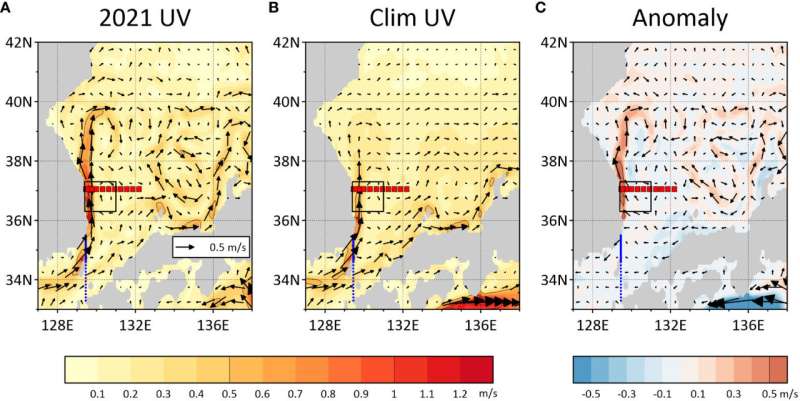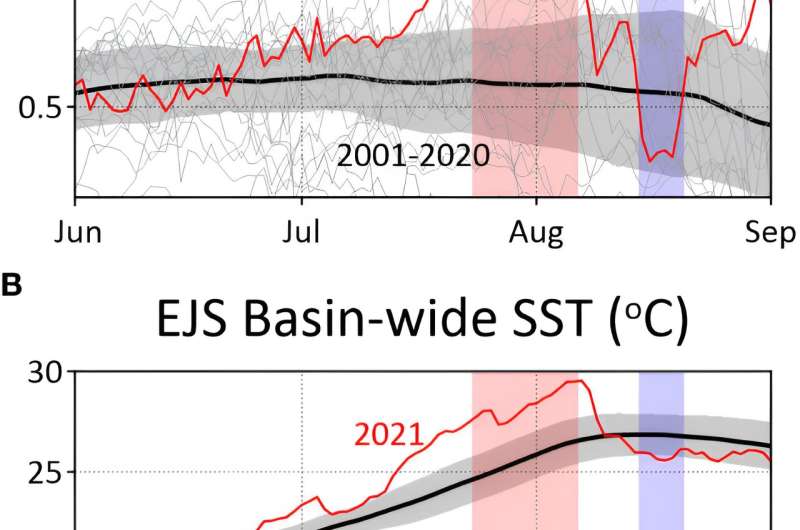December 27, 2023 feature
This article has been reviewed according to Science X's editorial process and policies. Editors have highlighted the following attributes while ensuring the content's credibility:
fact-checked
peer-reviewed publication
trusted source
proofread
Marine heat waves: Why the East Sea experienced extreme conditions in 2021

Extreme environmental events are becoming an ever more pressing concern with the continued stresses of climate change, both on land and in the marine realm. While terrestrial heat waves tend to occur over a few days, those in the oceans often have longer timescales of weeks to months.
An anomalous few weeks of extremely high temperatures occurred in the East Sea (Sea of Japan, northwest Pacific) during the summer of 2021, when one particular current experienced record-breaking changes in dominant patterns, first significantly intensifying before weakening. This was the East Korea Warm Current (EKWC), which is a western boundary current off the east coast of South Korea that occurs due to intensification of marine conditions in the west of the ocean basin, and carries warm water from the tropics poleward.
New research published in Frontiers in Marine Science has investigated the factors that likely resulted in this unusual event. Doctoral researcher Gyundo Pak, of the Korea Institute of Ocean Science and Technology, and colleagues determined a northward shift of the EKWC up to 40°N at the end of July 2021, alongside increased current speeds of 1.16m/s, measured from moorings on the seabed. These moorings also measured an increased volume of water transported via the EKWC during this time (more than double normal levels) into the East Sea, as it is a key inflow branch to the basin. However, by the middle of August, a rapid deceleration of the current saw it weaken to summer background levels of 0.5m/s.

The cause of such abrupt oceanographic change is attributed to temperature gradients between the coast and offshore locations and changes in wind patterns, linked to coastal downwelling and freshwater discharge from rivers that began to develop in early July 2021. In such locations, warm surface waters are "pushed" to greater depth, while cold-nutrient rich waters are prevented from reaching the surface along the coastal region, hence making them zones of low productivity for marine organisms. By the middle of August, wind patterns were further altered by a monsoon (Typhoon Lupit) that drove southerly wind-induced upwelling and thus altered surface temperatures.
Overall, the research team attribute an anomaly in ocean temperature as the main driver of the EKWC marine heat wave of 2021. The subsurface layer at a 200–300m water depth contributed the most to this temperature change, and was influenced by the nearby Ulleung Warm Eddy, a lens-shaped water mass that sits within the thermocline (transition between deeper cool water and warmer surface water). By August, this eddy was weakened by the passage of Typhoon Lupit.
Understanding the occurrence and cause of marine heat waves is vitally important not just for the health of our oceans, but for the people who rely on them for survival, such as global fishing communities that count fish as an important source of protein for a vast proportion of the world's population.
More information: Gyundo Pak et al, Quantification of the extremely intensified East Korea Warm Current in the summer of 2021: offshore and coastal variabilities, Frontiers in Marine Science (2023). DOI: 10.3389/fmars.2023.1252302
Journal information: Frontiers in Marine Science
© 2023 Science X Network




















